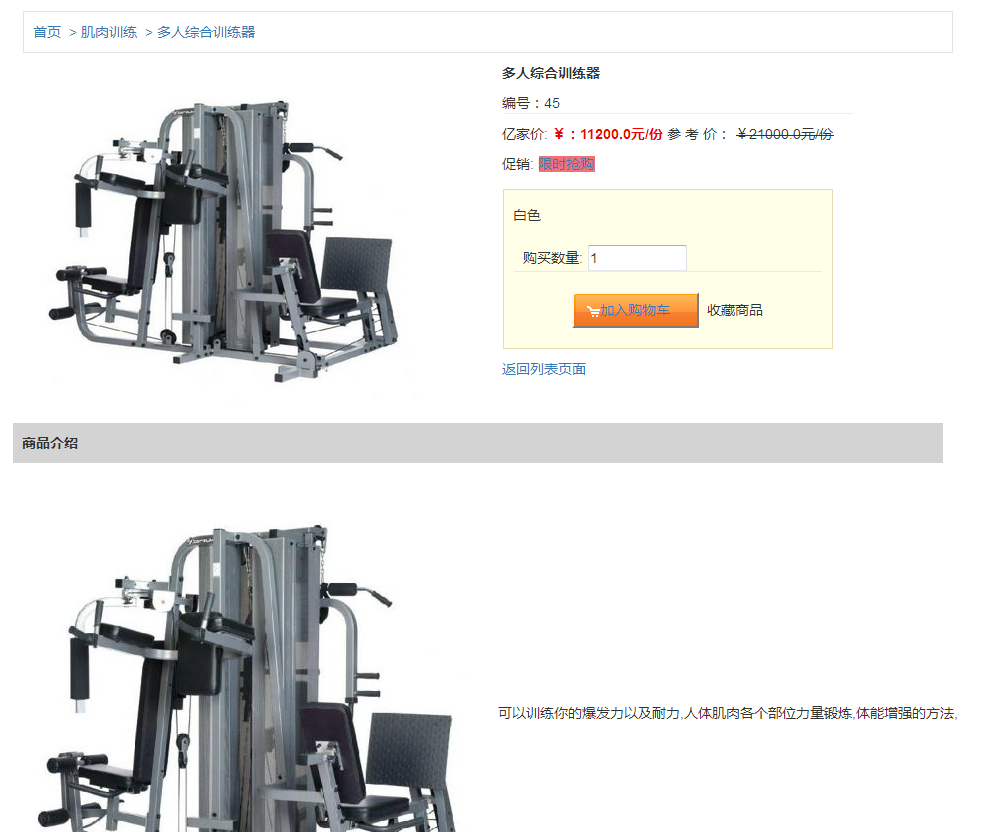今日任务
- 完成购物模块的功能
- 完成订单模块的功能
1.1 购物模块:
1.1.1 功能演示:
商品详情:

购物车模块:

1.1.2 代码实现:
1.在商品详情的页面中点击【加入购物车】链及.
2.提交到Servlet中:
* 提交购买的商品的数量.
* 提交购买的商品的ID.
3.将购物的信息存入到session中.
* 将购物车的信息存入到session中.
* 购物项对象的封装(购物车中的每个购买商品的信息)
* 商品的对象:
* 数量
* 小计
* 购物车对象的封装(购买所有商品的信息)
* 购物项的集合
* 总计
4.在页面中将购物车的信息获得到.
* 在页面中显示出来.
【购物项的实体的封装:CartItem】
public class CartItem { private Product product;// 购买的商品的信息 private int count; // 购买的数量 private double subtotal; // 购买商品的小计 public Product getProduct() { return product; } public void setProduct(Product product) { this.product = product; } public int getCount() { return count; } public void setCount(int count) { this.count = count; } public double getSubtotal() { return count * product.getShop_price(); } /*public void setSubtotal(double subtotal) { this.subtotal = subtotal; }*/ }
【购物车的实体:Cart】
public class Cart { // 定义一个购物项的集合的属性:集合采用Map集合,因为移除购物项的时候方便.使用商品的id作为Map的key // 使用购物项作为Map的value. private Map<String,CartItem> map = new LinkedHashMap<String,CartItem>(); // 定义购物车中的总计: private double total; public Map<String, CartItem> getMap() { return map; } public double getTotal() { return total; } // 方法:将购物项添加到购物车 public void addCart(CartItem cartItem){ // 判断购物车中是否已经存在该购物项. String id = cartItem.getProduct().getPid(); if(map.containsKey(id)){ // 如果已经存在:在原来的数量的基础上+新买的数量. 总计发生变化. // 获得购物车中的原来购物项的信息 CartItem _cartItem = map.get(id); _cartItem.setCount(_cartItem.getCount()+cartItem.getCount()); }else{ // 如果不存在:在集合中添加一个新的购物项. 总计发生变化. map.put(id, cartItem); } total += cartItem.getSubtotal(); } // 方法:从购物车中移除购物项 public void removeCart(String id){ // 从map中移除选中的元素. // CartItem cartItem = map.get(id); CartItem cartItem = map.remove(id); // 将总计 - 移除购物项的小计 total -= cartItem.getSubtotal(); } // 方法:清空购物车 public void clearCart(){ // // 将map集合清空. map.clear(); // 将总结设置为0. total = 0; } }
【在购物详情页面点击加入购物车的链接】
public String addCart(HttpServletRequest req,HttpServletResponse resp){ // 接收参数: String pid = req.getParameter("pid"); int count = Integer.parseInt(req.getParameter("count")); try { // 封装购物项: CartItem cartItem = new CartItem(); // 商品对象:通过商品ID查询商品. ProductService productService = (ProductService) BeanFactory.getBean("productService"); Product product = productService.findById(pid); cartItem.setProduct(product); cartItem.setCount(count); // 调用购物车中的添加到购物车的方法: // Cart cart = new Cart(); Cart cart = getCart(req); cart.addCart(cartItem); resp.sendRedirect(req.getContextPath()+"/jsp/cart.jsp"); } catch (Exception e) { e.printStackTrace(); throw new RuntimeException(); } return null; }
【在购物车页面点击清空购物车】
public String clearCart(HttpServletRequest req,HttpServletResponse resp){ // 获得购物车对象. Cart cart = getCart(req); // 调用购物车中的方法: cart.clearCart(); try { resp.sendRedirect(req.getContextPath()+"/jsp/cart.jsp"); } catch (Exception e) { e.printStackTrace(); throw new RuntimeException(); } return null; }
【在购物车页面点击删除链接】
public String removeCart(HttpServletRequest req,HttpServletResponse resp){ try { // 接收参数: String pid = req.getParameter("pid"); // 获得购物车: Cart cart = getCart(req); cart.removeCart(pid); // 页面跳转 resp.sendRedirect(req.getContextPath()+"/jsp/cart.jsp"); } catch (Exception e) { e.printStackTrace(); throw new RuntimeException(); } return null; }
1.2 订单模块:
1.2.1 功能演示:

1.2.2 代码实现:
1.2.2.1 创建表和实体:
CREATE TABLE `orders` ( `oid` varchar(32) NOT NULL, `ordertime` datetime DEFAULT NULL, `total` double DEFAULT NULL, `state` int(11) DEFAULT NULL, `address` varchar(30) DEFAULT NULL, `name` varchar(20) DEFAULT NULL, `telephone` varchar(20) DEFAULT NULL, `uid` varchar(32) DEFAULT NULL, PRIMARY KEY (`oid`) ) ENGINE=InnoDB DEFAULT CHARSET=utf8; CREATE TABLE `orderitem` ( `itemid` varchar(32) NOT NULL, `count` int(11) DEFAULT NULL, `subtotal` double DEFAULT NULL, `pid` varchar(32) DEFAULT NULL, `oid` varchar(32) DEFAULT NULL, PRIMARY KEY (`itemid`), KEY `fk_0001` (`pid`), KEY `fk_0002` (`oid`), CONSTRAINT `fk_0001` FOREIGN KEY (`pid`) REFERENCES `product` (`pid`), CONSTRAINT `fk_0002` FOREIGN KEY (`oid`) REFERENCES `orders` (`oid`) ) ENGINE=InnoDB DEFAULT CHARSET=utf8;
1.2.2.2 生成订单:
【在购物车的页面点击提交订单】
提交到Servlet:
* 封装订单和订单项.
* 调用业务层
* 清空购物车
* 页面跳转